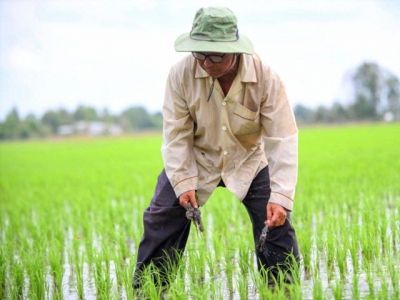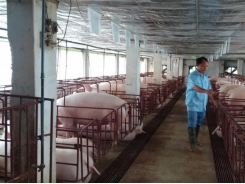Notable imprints of rice farmers in the Mekong Delta

Numerous models of advanced rice farming have helped increase the yield and quality of rice while also lowering the cost in the places where the VnSAT project was begun in the Mekong Delta.
Farmers tend to sow rice in the field in the VnSAT project area in Hau Giang. Photo: Huu Duc.
Utilizing novel methods
In the Mekong Delta, between 2015 and 2020 (extended to June 2022), the VnSAT project's compact on sustainable rice development in eight provinces, including An Giang, Can Tho, Dong Thap, Hau Giang, Kien Giang, Long An, Soc Trang, and Tien Giang, has witnessed numerous farmer efforts and progress in linking production. These advances have aided in the growth of agricultural cooperatives specialized in rice farming.
In particular, model "1 must 5 reductions" in implementing the technological process of rice intensification has aided farmers in increasing the efficiency of rice production.
My Trung Agricultural Service Cooperative is one of the cooperatives funded by the VnSAT project in My Trung commune, Cai Be district (Tien Giang). It is active in a variety of sectors, most notably rice farming.
Mr. Nguyen Van Thanh, the cooperative's director, enthusiastically emphasized that the cooperative's members and farmers who have joined the cooperative have reaped several benefits since the VnSAT project began three years ago. Specifically, in rice production, the program educates farmers about "3 reductions, 3 increases" and "1 must, 5 reductions," which have considerably altered farmers' practices.
Historically, farmers who practiced traditional sowing utilized between 15 and 20 kg of seed every 1,000 m2. People's density has decreased significantly in the modern era, down to 8-10 kg per 0.1 ha. According to Mr. Thanh, many family members were initially apprehensive when seeding reduction was first applied.
Due to the decrease in variety, the cooperative's farmers have been able to significantly reduce their use on fertilizers. Historically, farmers were required to fertilize at a rate of 40-45 kg per 0.1 ha. Chemical fertilizers are now limited to 20 kg per 0.1 ha and are supplemented with an extra 15 kg of organic fertilizers. This is particularly significant at the moment since fertilizer costs continue to rise.
The VnSAT project had a good effect on farmers in the project region, moving them from conventional rice farming to rice cultivation using the "3 reductions 3 increases" and "1 must 5 reductions" techniques.
Thus, by lowering seed planting, excess nitrogen fertilizer, pesticide application frequency, irrigation water use, and post-harvest losses, we may contribute to higher yield, quality, and profitability in rice cultivation. As a consequence, the average increase in rice production profit in the project region was 36.4 percent higher than in the non-project area.
Until recently, the majority of farmers in the VnSAT project region in Tien Giang have applied far less seed than in the past, owing to instruction in scientific field maintenance. According to the VnSAT Project Management Board in Tien Giang province, the project's aim for the "1 must 5 reductions" approach is to teach 34,560 individuals and to apply the technique over an area of 8,000 hectares after training.
Recent assessment findings for the winter-spring crop 2020-2021 in Tien Giang indicate that the total application rate of "three decreases, three increases" is 92.7 percent in terms of household count and 93.3 percent in terms of area. The proportion of households who employ the "1 must 5 reductions" is 97.5 percent in terms of household count and 98.8 percent in terms of area.
Production infrastructure be in good shape is a need
In Hau Giang, up to 14,000 agricultural families have been trained to practice "1 must 5 reductions." In Hau Giang, the VnSAT project implemented "1 must 5 reductions" on 14,680 hectares, significantly surpassing the objective.
Mr. Vo Minh Phuc, Deputy Director of the VnSAT Hau Giang Project Management Board, said that in order for farmers to effectively utilize modern rice-growing methods such as "3 decreases, 3 increases" and "1 must 5 decreases," adequate production infrastructure is required.
The VnSAT project's efficiency has paved the way for Hau Giang farmers to grow rice more effectively and responsibly. The use of a rice transplanter enables the quantity of seed rice to be reduced to 60-80 kg/ha, as opposed to 150-200 kg/ha for standard orchid seed.
Thus, inputs such as decreasing chemical fertilizers, particularly nitrogen fertilizers, reducing the number of times pesticides are sprayed, minimizing the effect on natural resources, most notably reducing irrigation water use by roughly 25% – 30%, and lowering irrigation costs are reduced. As a result, greenhouse gas emissions equal to about 166,249 tons are reduced (with the goal of reducing 113,333 tons).
Imprint of effectiveness
Mr. Doan Ngoc Pha, Deputy Director of the VnSAT An Giang Project Management Board, said that An Giang annually produces almost 700,000 hectares of rice. The province recommended farmers to use sophisticated technological solutions, emphasizing "3 reductions, 3 increases" and "1 must 5 reductions".
The province recommended farmers to use sophisticated technological solutions, emphasizing "3 reductions, 3 increases" and "1 must 5 reductions". Through production techniques, farmers have been able to considerably cut input costs while achieving greater yields and profitability than with earlier production strategies. From 2016 until the present, the VnSAT project has been executed in five districts and 45 communes, involving over 26,000 families and covering an area of over 38,600 hectares. Over 18,000 farmer families have been taught in the technical procedures "3 decreases, 3 increases" and "1 must 5 reductions," with over 25,000 hectares of farmland under cultivation.
Mr. Nguyen Sy Lam, Director of the An Giang Department of Agriculture and Rural Development, stated: "Agricultural production has encountered several problems in recent years as a result of the influence of climate change." As a result, the agricultural sector has consistently recommended that farmers encourage the adoption of new scientific and technological breakthroughs in order to boost production and lower investment costs.
Currently, farmers in An Giang province apply "three reductions and three raises" to 85 percent of rice crop area and "one must five reductions" to 50% of rice cropland. An Giang seeded almost 160,000 hectares of rice, mostly for the autumn-winter rice harvest of 2021, at the height of the Covid-19 outbreak prevention and management, and under the strain of high agricultural input costs, particularly fertilizers and pesticides. As a result, the answer "1 must 5 reductions" is critical and has several practical implications for profitably harvesting the crop.
The technological procedure "1 must 5 reductions" has been acknowledged as a technical advancement by the Department of Crop Production (MARD). Farmers now implement "1 must 5 reductions" in the VnSAT project area in Soc Trang, which equates to 20,000 hectares each crop with a two-crop/year production structure.
By May 2020, over 10,000 hectares of rice will be produced in the suburbs of Can Tho city with the implementation of the VnSAT project, accounting for more than 52% of the area. Farmers achieved a rise of 11% in earnings per hectare compared to farmers outside the initiative, a 3 percent gain over the pre-project level.
Related news
Tools

Phối trộn thức ăn chăn nuôi

Pha dung dịch thủy canh

Định mức cho tôm ăn

Phối trộn phân bón NPK

Xác định tỷ lệ tôm sống

Chuyển đổi đơn vị phân bón

Xác định công suất sục khí

Chuyển đổi đơn vị tôm

Tính diện tích nhà kính

Tính thể tích ao




 Rice straws and microbial products - the fertilizer-saving…
Rice straws and microbial products - the fertilizer-saving…  Terrified of antibiotics, farmer turns towards green husbandry
Terrified of antibiotics, farmer turns towards green husbandry